instrument panel MITSUBISHI OUTLANDER 2018 Owner's Manual (in English)
[x] Cancel search | Manufacturer: MITSUBISHI, Model Year: 2018, Model line: OUTLANDER, Model: MITSUBISHI OUTLANDER 2018Pages: 441, PDF Size: 13.71 MB
Page 24 of 441
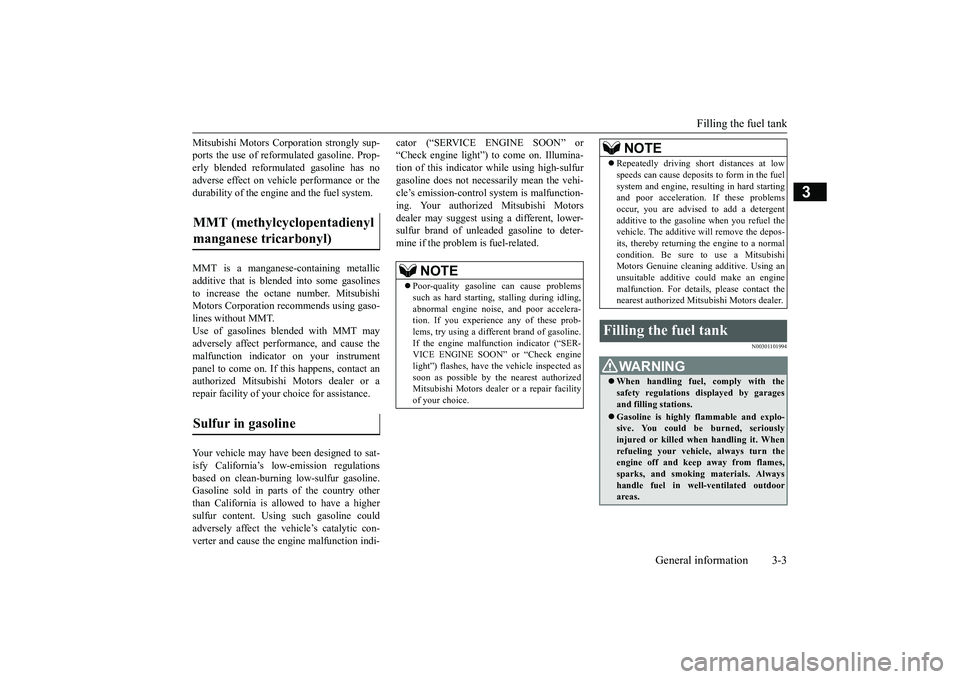
Filling the fuel tank
General information 3-3
3
Mitsubishi Motors Corporation strongly sup-ports the use of reform
ulated gasoline. Prop-
erly blended reformul
ated gasoline has no
adverse effect on vehicle performance or thedurability of the engine and the fuel system.MMT is a manganese-containing metallicadditive that is blende
d into some gasolines
to increase the octa
ne number. Mitsubishi
Motors Corporation recommends using gaso-lines without MMT.Use of gasolines blended with MMT mayadversely affect performance, and cause themalfunction indicator on your instrumentpanel to come on. If this happens, contact anauthorized Mitsubishi Motors dealer or arepair facility of your
choice for assistance.
Your vehicle may have
been designed to sat-
isfy California’s low-emission regulationsbased on clean-burning low-sulfur gasoline.Gasoline sold in parts of the country otherthan California is allowed to have a highersulfur content. Using such gasoline couldadversely affect the ve
hicle’s catalytic con-
verter and cause the e
ngine malfunction indi-
cator (“SERVICE ENGINE SOON” or“Check engine light”)
to come on. Illumina-
tion of this indicator
while using high-sulfur
gasoline does not necessa
rily mean the vehi-
cle’s emission-control
system is malfunction-
ing. Your authorized Mitsubishi Motorsdealer may suggest using a different, lower-sulfur brand of unleaded gasoline to deter-mine if the problem is fuel-related.
N00301101994
MMT (methylcyclopentadienyl manganese tricarbonyl) Sulfur in gasoline
NOTE
Poor-quality gasoline
can cause problems
such as hard starting, stalling during idling,abnormal engine noise
, and poor accelera-
tion. If you experience any of these prob-lems, try using a differ
ent brand of gasoline.
If the engine malfunc
tion indicator (“SER-
VICE ENGINE SOON” light”) flashes, have
the vehicle inspected as
soon as possible by the nearest authorizedMitsubishi Motors dealer
or a repair facility
of your choice.
Repeatedly driving s
hort distances at low
speeds can cause deposits to form in the fuelsystem and engine, resu
lting in hard starting
and poor acceleration.
If these problems
occur, you are advised to add a detergentadditive to the gasoline when you refuel thevehicle. The additive
will remove the depos-
its, thereby returning the engine to a normalcondition. Be sure
to use a Mitsubishi
Motors Genuine cleani
ng additive. Using an
unsuitable additive could make an enginemalfunction. For details,
please contact the
nearest authorized Mitsubishi Motors dealer.
Filling the fuel tank
WA R N I N GWhen handling fuel, comply with thesafety regulations displayed by garagesand filling stations.Gasoline is highly flammable and explo-sive. You could be burned, seriouslyinjured or killed when handling it. Whenrefueling your vehicle,
always turn the
engine off and keep
away from flames,
sparks, and smoking materials. Alwayshandle fuel in well-ventilated outdoorareas.NOTE
BK0249100US.book 3 ページ 2017年5月10日 水曜日 午前8時49分
Page 52 of 441
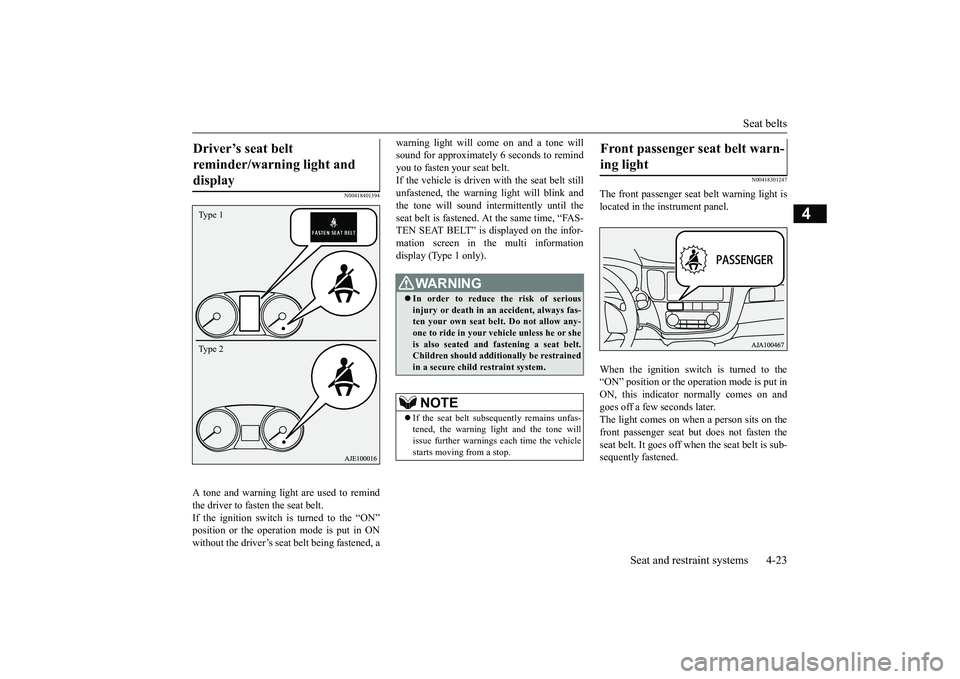
Seat belts
Seat and restraint systems 4-23
4
N00418401394
A tone and warning light are used to remindthe driver to fasten the seat belt.If the ignition switch is turned to the “ON”without the driver’s seat belt being fastened, a
warning light will co
me on and a tone will
sound for approximately
6 seconds to remind
you to fasten your seat belt.If the vehicle is driven with the seat belt stillunfastened, the warning light will blink andthe tone will sound inte
rmittently until the
seat belt is fastened. At the same time, “FAS-TEN SEAT BELT” is displayed on the infor-mation screen in the multi informationdisplay (Type 1 only).
N00418301247
The front passenger seat
belt warning light is
located in the instrument panel.When the ignition switch is turned to the“ON” position or the operation mode is put inON, this indicator
normally comes on and
goes off a few seconds later.The light comes on when a person sits on thefront passenger seat bu
t does not fasten the
seat belt. It goes off when the seat belt is sub-sequently fastened.
Driver’s seat belt reminder/warning light and display Type 1Type 2
WA R N I N GIn order to reduce the risk of seriousinjury or death in an
accident, always fas-
ten your own seat belt
. Do not allow any-
one to ride in your ve
hicle unless he or she
is also seated and fastening a seat belt.Children should additi
onally be restrained
in a secure child restraint system.NOTE
If the seat belt subse
quently remains unfas-
tened, the warning li
ght and the tone will
issue further warnings
each time the vehicle
starts moving from a stop.
Front passenger seat belt warn-ing light
BK0249100US.book 23 ページ 2017年5月10日 水曜日 午前8時49分
Page 65 of 441
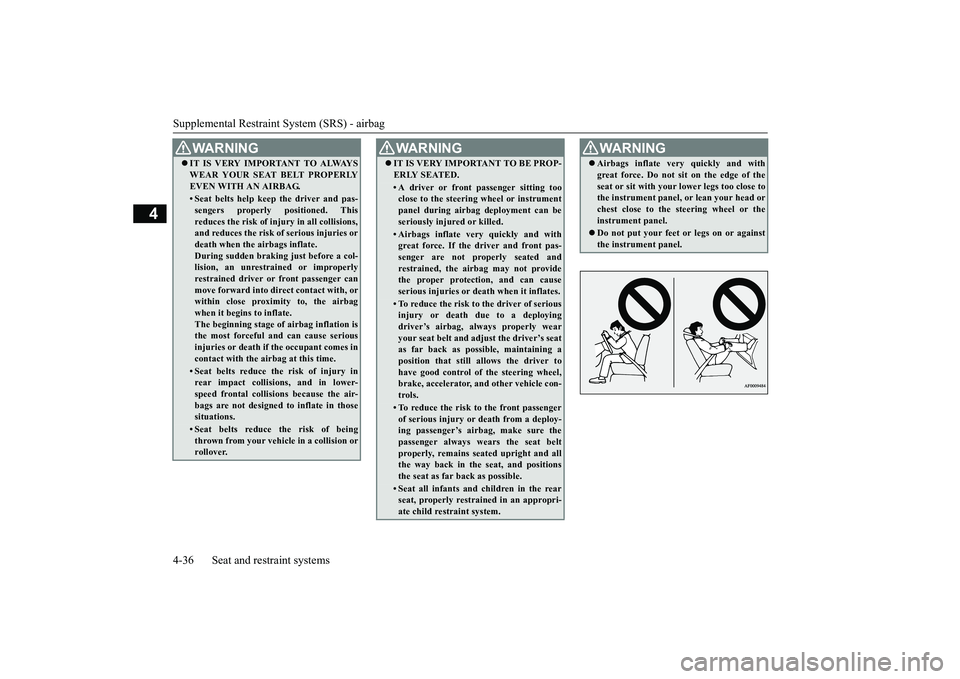
Supplemental Restraint System (SRS) - airbag4-36 Seat and restraint systems
4
WA R N I N GIT IS VERY IMPORTANT TO ALWAYSWEAR YOUR SEAT BELT PROPERLYEVEN WITH AN AIRBAG.• Seat belts help keep the driver and pas-sengers properly positioned. Thisreduces the risk of injury in all collisions,and reduces the risk of serious injuries ordeath when the airbags inflate.During sudden brakin
g just before a col-
lision, an unrestra
ined or improperly
restrained driver or front passenger canmove forward into di
rect contact with, or
within close proximity to, the airbagwhen it begins to inflate.The beginning stage of
airbag inflation is
the most forceful and can cause seriousinjuries or death if the occupant comes incontact with the ai
rbag at this time.
• Seat belts reduce the risk of injury inrear impact collisions, and in lower-speed frontal collisions because the air-bags are not designed
to inflate in those
situations.• Seat belts reduce the risk of beingthrown from your vehi
cle in a collision or
rollover.
WA R N I N GIT IS VERY IMPORTANT TO BE PROP-ERLY SEATED.• A driver or front passenger sitting tooclose to the steering wheel or instrumentpanel during airbag deployment can beseriously injure
d or killed.
• Airbags inflate ve
ry quickly and with
great force. If the driver and front pas-senger are not properly seated andrestrained, the airbag may not providethe proper protection, and can causeserious injuries or death when it inflates.• To reduce the risk to the driver of seriousinjury or death due to a deployingdriver’s airbag, al
ways properly wear
your seat belt and ad
just the driver’s seat
as far back as possible, maintaining aposition that still
allows the driver to
have good control of the steering wheel,brake, accelerator,
and other vehicle con-
trols.• To reduce the risk to the front passengerof serious injury or death from a deploy-ing passenger’s airbag, make sure thepassenger always we
ars the seat belt
properly, remains seat
ed upright and all
the way back in the seat, and positionsthe seat as far back as possible.• Seat all infants and children in the rearseat, properly restrain
ed in an appropri-
ate child restraint system.
WA R N I N GAirbags inflate very
quickly and with
great force. Do not sit on the edge of theseat or sit with your
lower legs too close to
the instrument panel,
or lean your head or
chest close to the steering wheel or theinstrument panel.Do not put your feet or
legs on or against
the instrument panel.
BK0249100US.book 36 ページ 2017年5月10日 水曜日 午前8時49分
Page 66 of 441
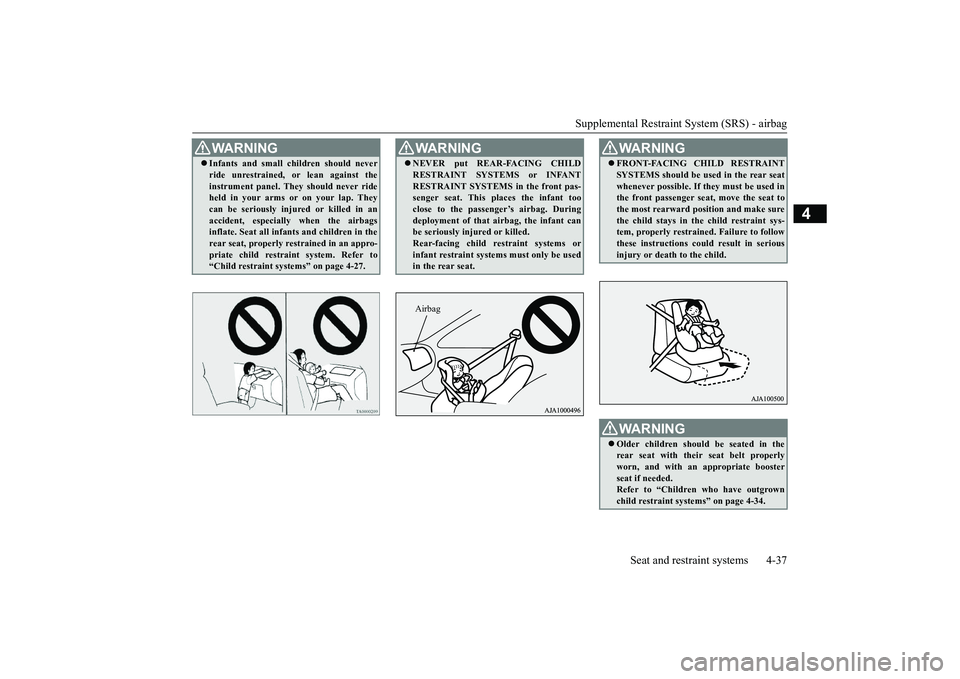
Supplemental Restraint System (SRS) - airbag
Seat and restraint systems 4-37
4
WA R N I N GInfants and small children should neverride unrestrained,
or lean against the
instrument panel. They should never rideheld in your arms or on your lap. Theycan be seriously inju
red or killed in an
accident, especially when the airbagsinflate. Seat all infants and children in therear seat, properly re
strained in an appro-
priate child restraint system. Refer to“Child restraint syst
ems” on page 4-27.
WA R N I N GNEVER put REAR-FACING CHILDRESTRAINT SYSTEMS or INFANTRESTRAINT SYSTEMS in the front pas-senger seat. This places the infant tooclose to the passenger’s airbag. Duringdeployment of that airbag, the infant canbe seriously inju
red or killed.
Rear-facing child restraint systems orinfant restraint systems must only be usedin the rear seat.Airbag
WA R N I N GFRONT-FACING CHILD RESTRAINTSYSTEMS should be used in the rear seatwhenever possible. If they must be used inthe front passenger seat, move the seat tothe most rearward position and make surethe child stays in the child restraint sys-tem, properly restrained. Failure to followthese instructions could result in seriousinjury or death to the child.WA R N I N GOlder children should be seated in therear seat with their seat belt properlyworn, and with an
appropriate booster
seat if needed.Refer to “Children
who have outgrown
child restraint syst
ems” on page 4-34.
BK0249100US.book 37 ページ 2017年5月10日 水曜日 午前8時49分
Page 68 of 441
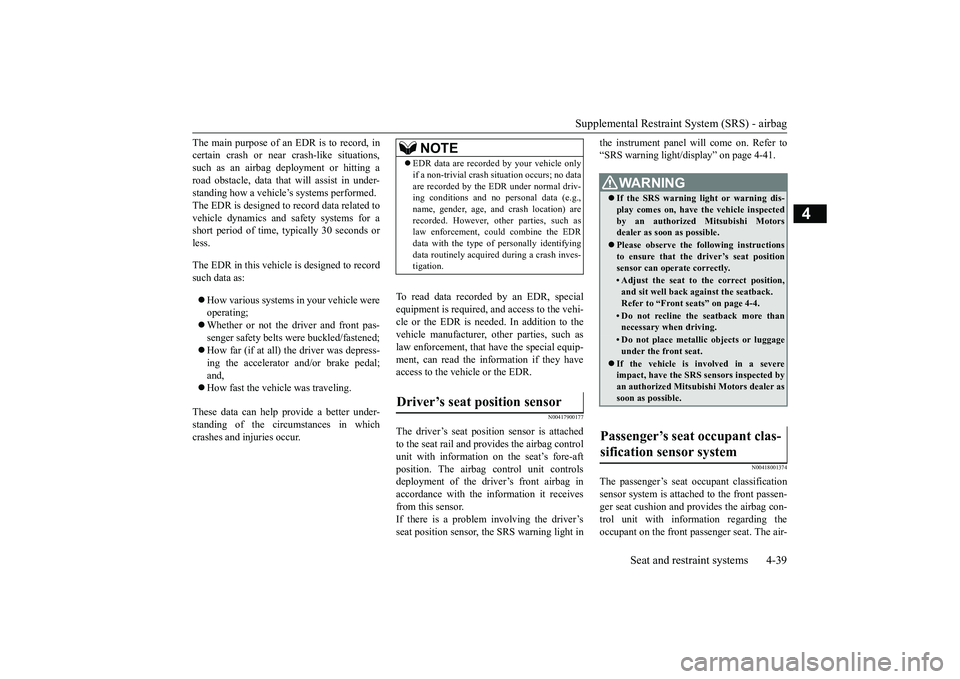
Supplemental Restraint System (SRS) - airbag
Seat and restraint systems 4-39
4
The main purpose of an EDR is to record, incertain crash or near
crash-like situations,
such as an airbag deployment or hitting aroad obstacle, data that
will assist in under-
standing how a vehicl
e’s systems performed.
The EDR is designed to record data related tovehicle dynamics and safety systems for ashort period of time,
typically 30 seconds or
less.The EDR in this vehicle is designed to recordsuch data as:How various systems
in your vehicle were
operating;Whether or not the driver and front pas-senger safety belts we
re buckled/fastened;
How far (if at all) the driver was depress-ing the accelerator and/or brake pedal;and,How fast the vehicle was traveling.
These data can help provide a better under-standing of the circumstances in whichcrashes and injuries occur.
To read data recorded by an EDR, specialequipment is required, and access to the vehi-cle or the EDR is needed. In addition to thevehicle manufacturer, ot
her parties, such as
law enforcement, that have the special equip-ment, can read the information if they haveaccess to the vehicle or the EDR.
N00417900177
The driver’s seat position sensor is attachedto the seat rail and provides the airbag controlunit with information on the seat’s fore-aftposition. The airbag control unit controlsdeployment of the driver’s front airbag inaccordance with the information it receivesfrom this sensor.If there is a problem involving the driver’sseat position sensor, the SRS warning light in
the instrument panel will come on. Refer to“SRS warning light/dis
play” on page 4-41.
N00418001374
The passenger’s seat oc
cupant classification
sensor system is attach
ed to the front passen-
ger seat cushion and provides the airbag con-trol unit with information regarding theoccupant on the front passenger seat. The air-
NOTE
EDR data are recorded by your vehicle onlyif a non-trivial crash si
tuation occurs; no data
are recorded by the EDR under normal driv-ing conditions and no personal data (e.g.,name, gender, age, a
nd crash location) are
recorded. However, ot
her parties, such as
law enforcement, could combine the EDRdata with the type of
personally identifying
data routinely acquire
d during a crash inves-
tigation.
Driver’s seat position sensor
WA R N I N GIf the SRS warning light or warning dis-play comes on, have the vehicle inspectedby an authorized Mitsubishi Motorsdealer as soon as possible.Please observe the following instructionsto ensure that the driver’s seat positionsensor can operate correctly.• Adjust the seat to the correct position,and sit well back
against the seatback.
Refer to “Front seats” on page 4-4.• Do not recline the seatback more thannecessary when driving.• Do not place metallic objects or luggageunder the front seat.
If the vehicle is involved in a severeimpact, have the SRS sensors inspected byan authorized
Mitsubishi Motors dealer as
soon as possible.
Passenger’s seat occupant clas-sification sensor system
BK0249100US.book 39 ページ 2017年5月10日 水曜日 午前8時49分
Page 69 of 441
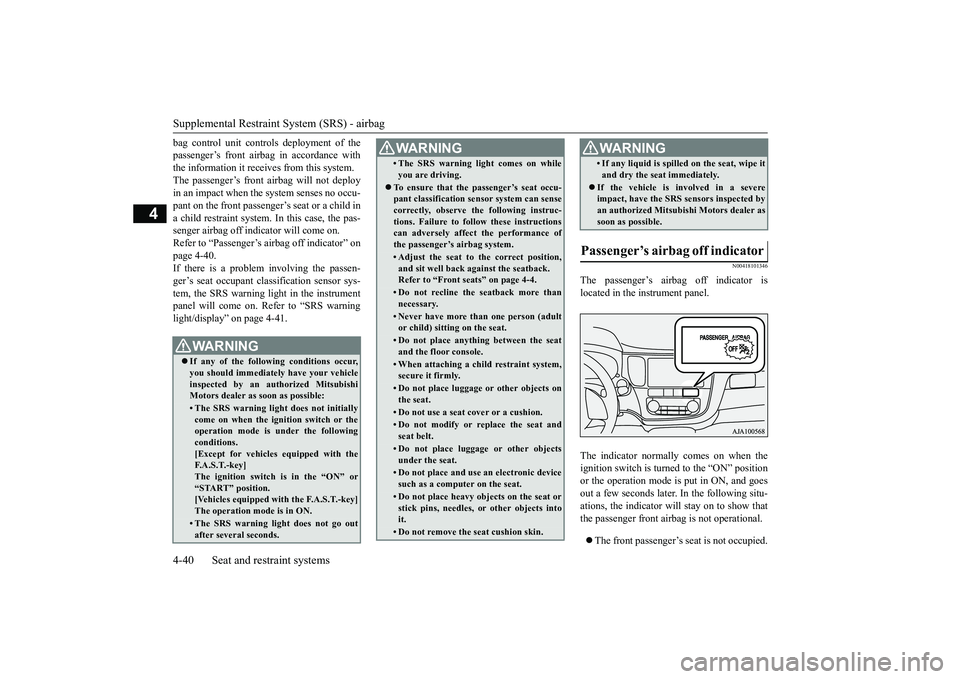
Supplemental Restraint System (SRS) - airbag4-40 Seat and restraint systems
4
bag control unit controls deployment of thepassenger’s front airbag in accordance withthe information it receives from this system.The passenger’s front airbag will not deployin an impact when the system senses no occu-pant on the front passenger’s seat or a child ina child restraint system. In this case, the pas-senger airbag off indi
cator will come on.
Refer to “Passenger’s ai
rbag off indicator” on
page 4-40.If there is a problem involving the passen-ger’s seat occupant cl
assification sensor sys-
tem, the SRS warning light in the instrumentpanel will come on. Refer to “SRS warninglight/display” on page 4-41.
N00418101346
The passenger’s airbag off indicator islocated in the instrument panel.The indicator normally comes on when theignition switch is turned to the “ON” positionor the operation mode is put in ON, and goesout a few seconds later.
In the following situ-
ations, the indicator will stay on to show thatthe passenger front airb
ag is not operational.
The front passenger’s seat is not occupied.
WA R N I N GIf any of the follow
ing conditions occur,
you should immediatel
y have your vehicle
inspected by an au
thorized Mitsubishi
Motors dealer as soon as possible:• The SRS warning light does not initiallycome on when the ignition switch or theoperation mode is under the followingconditions.[Except for vehicles equipped with theF. A . S . T. - k e y ]The ignition switch is in the “ON” or“START” position.[Vehicles equipped with the F.A.S.T.-key]The operation mode is in ON.• The SRS warning light does not go outafter several seconds.
• The SRS warning li
ght comes on while
you are driving.
To ensure that the passenger’s seat occu-pant classification sensor system can sensecorrectly, observe the following instruc-tions. Failure to follow these instructionscan adversely affect
the performance of
the passenger’s airbag system.• Adjust the seat to the correct position,and sit well back
against the seatback.
Refer to “Front seats” on page 4-4.• Do not recline the seatback more thannecessary.• Never have more th
an one person (adult
or child) sitting on the seat.• Do not place anything between the seatand the floor console.• When attaching a child restraint system,secure it firmly.• Do not place luggage or other objects onthe seat.• Do not use a seat cover or a cushion.• Do not modify or re
place the seat and
seat belt.• Do not place luggage or other objectsunder the seat.• Do not place and use
an electronic device
such as a computer on the seat.• Do not place heavy obje
cts on the seat or
stick pins, needles, or other objects intoit.• Do not remove the seat cushion skin.WA R N I N G
• If any liquid is spilled on the seat, wipe itand dry the seat immediately.
If the vehicle is involved in a severeimpact, have the SRS sensors inspected byan authorized
Mitsubishi Motors dealer as
soon as possible.
Passenger’s airbag off indicator
WA R N I N G
BK0249100US.book 40 ページ 2017年5月10日 水曜日 午前8時49分
Page 70 of 441
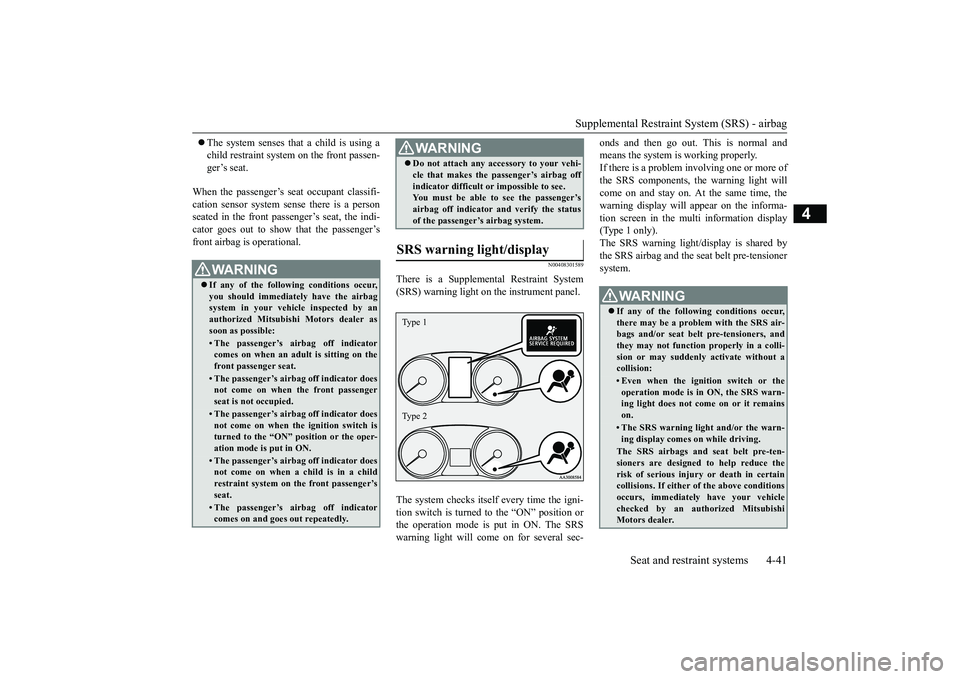
Supplemental Restraint System (SRS) - airbag
Seat and restraint systems 4-41
4
The system senses that a child is using achild restraint system
on the front passen-
ger’s seat.
When the passenger’s se
at occupant classifi-
cation sensor system sense there is a personseated in the front passenger’s seat, the indi-cator goes out to show that the passenger’sfront airbag is operational.
N00408301589
There is a Supplemen
tal Restraint System
(SRS) warning light on the instrument panel.The system checks itself every time the igni-tion switch is turned to the “ON” position orthe operation mode is put in ON. The SRSwarning light will come on for several sec-
onds and then go out. This is normal andmeans the system is working properly.If there is a problem
involving one or more of
the SRS components, the warning light willcome on and stay on. At
the same time, the
warning display will appear on the informa-tion screen in the multi information display(Type 1 only).The SRS warning light/display is shared bythe SRS airbag and the se
at belt pre-tensioner
system.
WA R N I N GIf any of the following conditions occur,you should immediat
ely have the airbag
system in your vehicle inspected by anauthorized Mitsubishi
Motors dealer as
soon as possible:• The passenger’s airbag off indicatorcomes on when an adul
t is sitting on the
front passenger seat.• The passenger’s airbag off indicator doesnot come on when the front passengerseat is not occupied.• The passenger’s airbag off indicator doesnot come on when the ignition switch isturned to the “ON” position or the oper-ation mode is put in ON.• The passenger’s airbag off indicator doesnot come on when a
child is in a child
restraint system on the front passenger’sseat.• The passenger’s airbag off indicatorcomes on and goes out repeatedly.
Do not attach any accessory to your vehi-cle that makes the passenger’s airbag offindicator difficult or
impossible to see.
You must be able to see the passenger’sairbag off indicator an
d verify the status
of the passenger’s airbag system.
SRS warning light/display
WA R N I N G
Type 1Type 2
WA R N I N GIf any of the following conditions occur,there may be a problem with the SRS air-bags and/or seat belt
pre-tensioners, and
they may not function
properly in a colli-
sion or may suddenly
activate without a
collision:•Even when the igniti
on switch or the
operation mode is in ON, the SRS warn-ing light does not come on or it remainson.• The SRS warning light and/or the warn-ing display comes
on while driving.
The SRS airbags and
seat belt pre-ten-
sioners are designed to help reduce therisk of serious injury
or death in certain
collisions. If either of the above conditionsoccurs, immediately
have your vehicle
checked by an auth
orized Mitsubishi
Motors dealer.
BK0249100US.book 41 ページ 2017年5月10日 水曜日 午前8時49分
Page 71 of 441
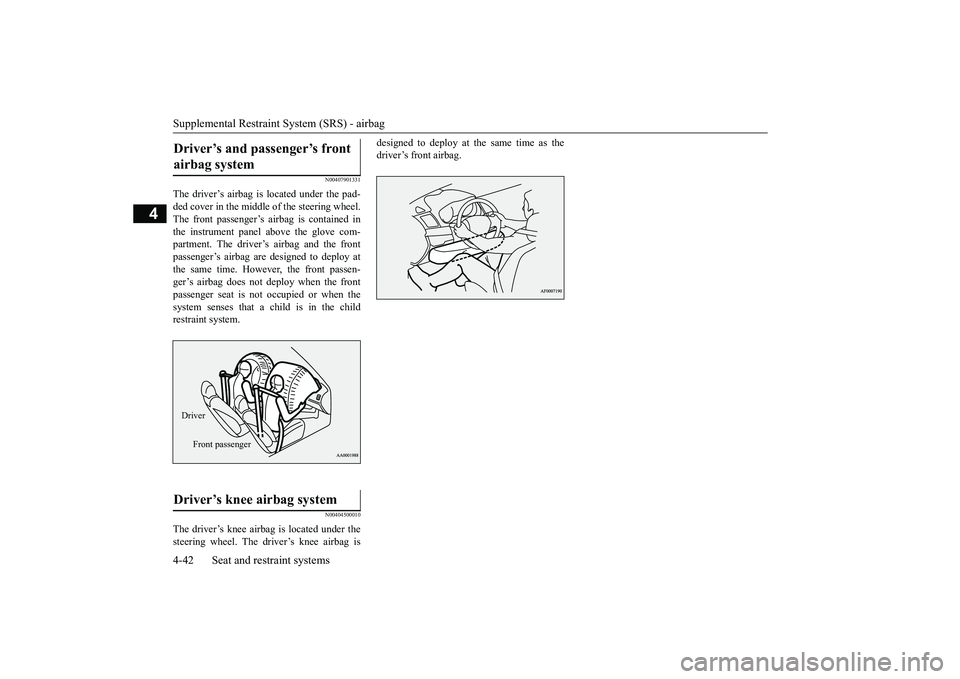
Supplemental Restraint System (SRS) - airbag4-42 Seat and restraint systems
4
N00407901331
The driver’s airbag is located under the pad-ded cover in the middle of the steering wheel.The front passenger’s ai
rbag is contained in
the instrument panel above the glove com-partment. The driver’s airbag and the frontpassenger’s airbag are designed to deploy atthe same time. However, the front passen-ger’s airbag does not deploy when the frontpassenger seat is not occupied or when thesystem senses that a child is in the childrestraint system.
N00404500010
The driver’s knee airbag is located under thesteering wheel. The driver’s knee airbag is
designed to deploy at
the same time as the
driver’s front airbag.
Driver’s and passenger’s front airbag system Driver’s knee airbag system Driver
Front passenger
BK0249100US.book 42 ページ 2017年5月10日 水曜日 午前8時49分
Page 74 of 441
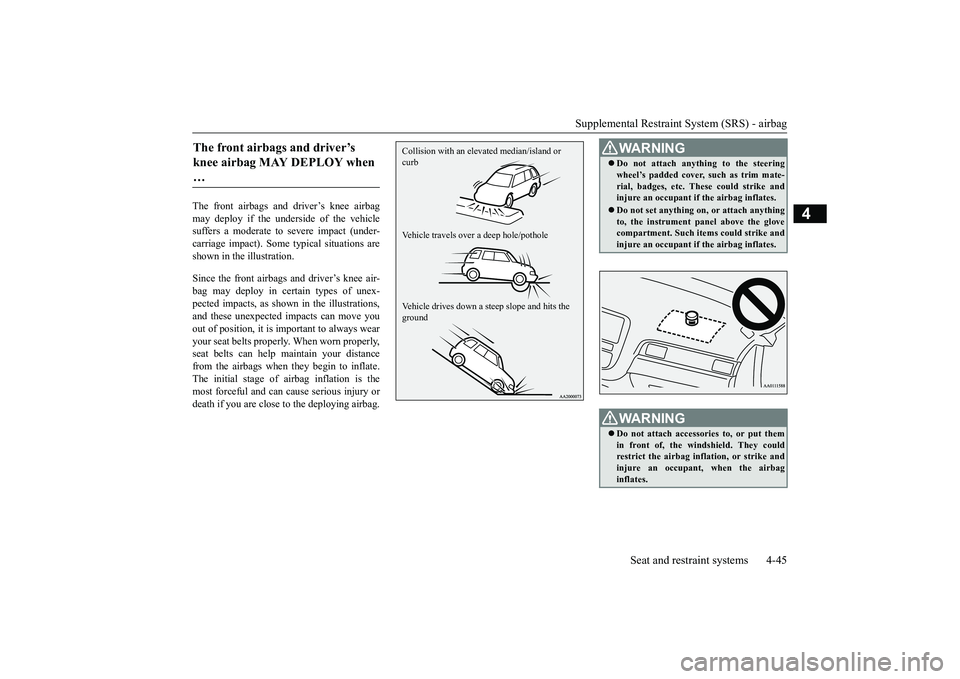
Supplemental Restraint System (SRS) - airbag
Seat and restraint systems 4-45
4
The front airbags and driver’s knee airbagmay deploy if the underside of the vehiclesuffers a moderate to
severe impact (under-
carriage impact). Some typical situations areshown in the illustration.Since the front airbags and driver’s knee air-bag may deploy in ce
rtain types of unex-
pected impacts, as show
n in the illustrations,
and these unexpected impacts can move youout of position, it is
important to always wear
your seat belts properly. When worn properly,seat belts can help maintain your distancefrom the airbags when they begin to inflate.The initial stage of airbag inflation is themost forceful and can cause serious injury ordeath if you are close to the deploying airbag.The front airbags and driver’s knee airbag MAY DEPLOY when …
Collision with an elevat
ed median/island or
curbVehicle travels over a deep hole/potholeVehicle drives down a steep slope and hits the ground
WA R N I N GDo not attach anything to the steeringwheel’s padded cover, such as trim mate-rial, badges, etc. These could strike andinjure an occupant if
the airbag inflates.
Do not set anything on, or attach anythingto, the instrument
panel above the glove
compartment. Such items could strike andinjure an occupant if
the airbag inflates.
WA R N I N GDo not attach accessories to, or put themin front of, the wind
shield. They could
restrict the airbag infl
ation, or strike and
injure an occupant, when the airbaginflates.
BK0249100US.book 45 ページ 2017年5月10日 水曜日 午前8時49分
Page 75 of 441
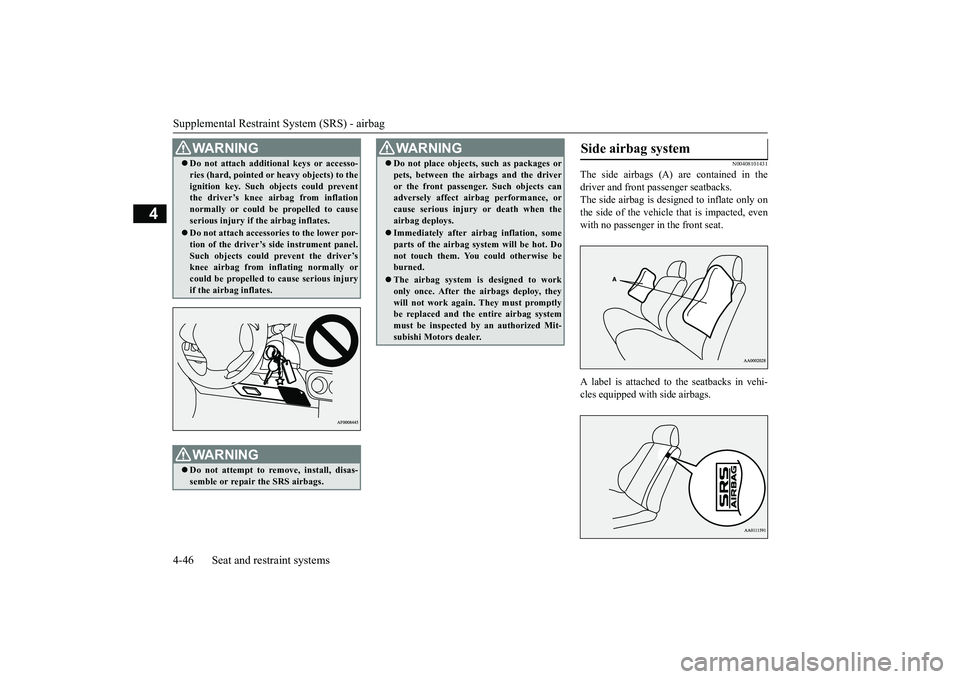
Supplemental Restraint System (SRS) - airbag4-46 Seat and restraint systems
4
N00408101431
The side airbags (A) are contained in thedriver and front passenger seatbacks.The side airbag is de
signed to inflate only on
the side of the vehicle that is impacted, evenwith no passenger in the front seat.A label is attached to the seatbacks in vehi-cles equipped with side airbags.
Do not attach addition
al keys or accesso-
ries (hard, pointed or
heavy objects) to the
ignition key. Such objects could preventthe driver’s knee ai
rbag from inflation
normally or could be propelled to causeserious injury if
the airbag inflates.
Do not attach accessories to the lower por-tion of the driver’s side instrument panel.Such objects could prevent the driver’sknee airbag from inflating normally orcould be propelled to cause serious injuryif the airbag inflates.WA R N I N GDo not attempt to remove, install, disas-semble or repair the SRS airbags.WA R N I N G
Do not place objects,
such as packages or
pets, between the airbags and the driveror the front passenger. Such objects canadversely affect ai
rbag performance, or
cause serious injury or death when theairbag deploys.Immediately after airbag inflation, someparts of the airbag syst
em will be hot. Do
not touch them. You could otherwise beburned.The airbag system is designed to workonly once. After the
airbags deploy, they
will not work again. They must promptlybe replaced and the
entire airbag system
must be inspected by
an authorized Mit-
subishi Motors dealer.WA R N I N G
Side airbag system
BK0249100US.book 46 ページ 2017年5月10日 水曜日 午前8時49分